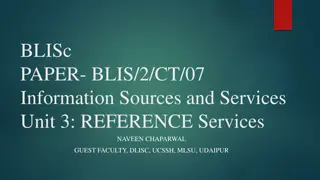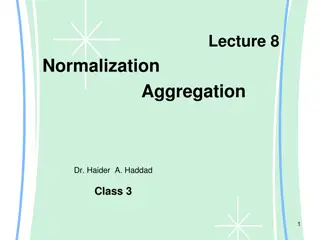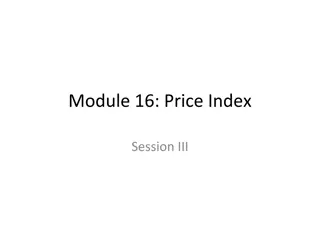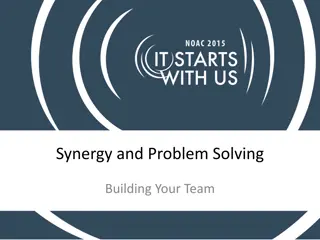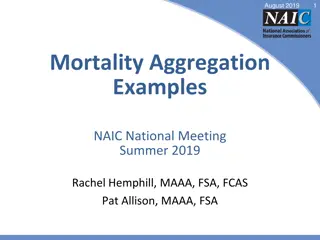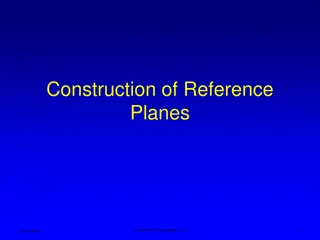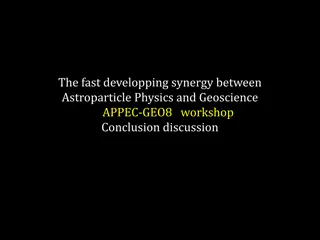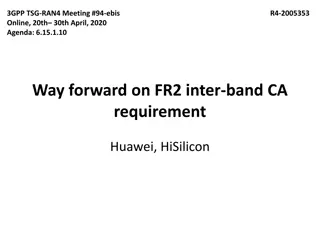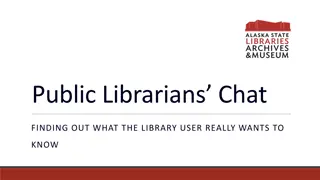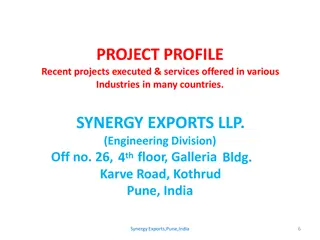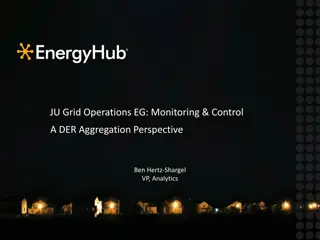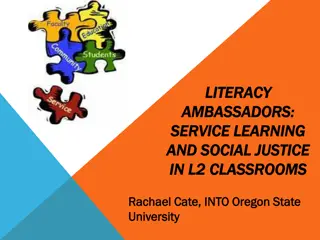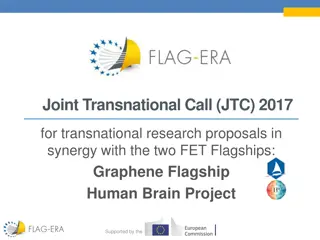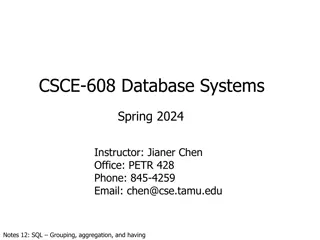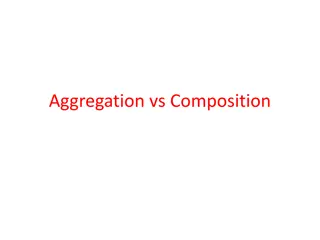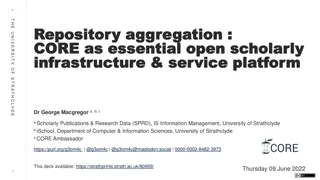SYNERGY Reference Model for Data Provision and Aggregation
The SYNERGY Reference Model, developed by a team of respected contributors, outlines strategies for effective data provision and aggregation. Led by renowned experts from FORTH, the model offers valuable insights for enhancing research practices and data management processes.
Download Presentation

Please find below an Image/Link to download the presentation.
The content on the website is provided AS IS for your information and personal use only. It may not be sold, licensed, or shared on other websites without obtaining consent from the author. Download presentation by click this link. If you encounter any issues during the download, it is possible that the publisher has removed the file from their server.
E N D
Presentation Transcript
The SYNERGY Reference Model of Data Provision and Aggregation Current Contributors: Martin Doerr, Gerald de Jong, Konstantina Konsolaki, Barry Norton, Dominic Oldman, Maria Theodoridou, Thomas Wikman Foundation for Research and Technology Hellas (FORTH) Institute of Computer Science (ICS) Information Systems Laboratory (ISL) 1 FORTH-ICS
Outline Introduction Process Model User Roles Process Hierarchy Processes Data Objects IT Objects 2 FORTH-ICS
Introduction 3 FORTH-ICS
Introduction (1/3) Goal: Describe the provision of data between providers and aggregators including associated data mapping components Address the lack of functionality in current models (OAIS) and practice (all European research infrastructures and some DLs) Incorporate the necessary knowledge and input needed from providers to create quality sustainable aggregations 4 FORTH-ICS
Introduction (2/3) Assumption: Distribution of responsibilities: Provider: 1. Curates his resources 2. Has knowledge to verify record contents 3. Provides in regular intervals updates (push or pull) Aggregator: 1. Provides the homogeneous access to the integrated data 2. Has mechanisms for recognizing (potential) co-references across all provided data 3. Can coordinate processes of recognizing and correcting inconsistencies between all involved parties (end-user, aggregator, provider). Challenge: Define a modular architecture that can be developed and optimized by different developers with minimal inter-dependencies and without hindering integrated UI development for the different user roles involved 5 FORTH-ICS
Introduction (3/3) 6 FORTH-ICS
Introduction (4/4) 7 FORTH-ICS
Process Model User Roles 8 FORTH-ICS
User Roles (1/6) Organizations Performers Roles 9 FORTH-ICS
User Roles (2/6) User Roles: Primary User Roles: The managerially responsible members from the Provider and the Aggregator Institution that agree to perform the data provisioning of the providers local information systems to the aggregator s integrated access system. Secondary User Roles: The experts whose knowledge or services contribute to the implementation and realization of the data provisioning process. 10 FORTH-ICS
User Roles (3/6) Primary User Roles: Provider Institution: An institution (a.k.a. source systems) that maintains collection management systems or content management systems, that constitute institutional memories. They are used for primary data entry. Provider Curator: The curator of the source systems. They have the knowledge about the meaning of their data in the real world (if anybody has it), or know who knows, or know how to verify it. 11 FORTH-ICS
User Roles (4/6) Primary User Roles: Aggregator Institution: It maintains an Integrated Access System (a.k.a. target systems), which provides a homogeneous access layer to multiple local systems. The origin of the information it manages are the Provider Institutions it maintains a business relation with. It may not produce new content except for co-reference resolution information. Mapping Manager: The actor responsible for the maintenance of the data transformation process from the provider format to the aggregator format. He may belong to the provider or aggregator institution or both, or be in a superior position to both. 12 FORTH-ICS
User Roles (5/6) Secondary User Roles: Provider Data Manager: The responsible for managing the IT systems of the provider and handling data assets, in contrast to the responsible for entering content. In particular, the responsible for sending data to the aggregator. Provider Terminology Expert: The curator, maintainer or other expert of one of the terminologies which the provider institutions use as reference in the local system. Provider Schema Expert: The curator(s), researcher(s) and/or data manager(s) of the Provider Institution who are responsible for the data entry into their local systems. Aggregator Schema Expert: The expert(s) for the semantics of the schema employed by the aggregator. 13 FORTH-ICS
User Roles (6/6) Secondary User Roles: Schema Matching Experts: Source schema experts and a target schema expert collaborate in order to define a schema matching, which is documented in a schema matching definition file. Instance Generation Expert: The expert of the aggregator, normally an IT specialist, who is responsible for maintaining the referential integrity of the (meta)data in the Integrated Access System and who knows how to generate from provider data valid instance definitions, such as URIs, additional labels and data values for the Integrated Access System. Aggregator Terminology Expert: The curator, maintainer or other expert of one of the terminologies that the aggregator uses as reference in the Integrated Access System. Ingest Manager: The responsible for receiving data from the provider and ingesting data into the target system. 14 FORTH-ICS
Process Model Process Hierarchy 15 FORTH-ICS
Process Hierarchy 16 FORTH-ICS
Process Model Processes 17 FORTH-ICS
Data Provisioning Process The Data Provisioning process which deals with the selection and scheduling of data, including co-reference resolution and updates. A Mapping Manager may be responsible for this task. 18 FORTH-ICS
Initial Data Delivery Sub-Process Initial Data Delivery breaks down into: Syntax Normalization Mapping Definition Metadata Transfer 19 FORTH-ICS
Provider Institution Provider Schema Definition Raw Metadata Raw Metadata Source Statistics Syntax Normalizer Source Analyzer Effective Provider Schema Target Schema Validator Target Schema Definition Source Syntax Report Normalized Provider Metadata Target Schema Visualizer Mapping Memory Source Schema Validator Mapping Suggester Source Statistics Source Analyzer Source Schema Visualizer Schema Matcher Provider Terminology Aggregator Terminology Instance Generation Rule Builder Schema Matching Definition Schema Mapping Viewer Terminology Mapper Mapping Definition Terminology Mapping 3Meditor Metadata Validator Transformer Mapping Validation Report Source To Target URI Association Table Aggregator Format Records Aggregator Statistics Report Aggregator Institution Target Analyzer
Syntax Normalization Syntax normalization aims to convert all data structures relevant for the transformation in a standard form since data transformation tools can only deal with a limited set of standard data structures and thus any non-standard form must be converted to a standard one. 21 FORTH-ICS
Mapping Definition Mapping Definition consists of the: Schema Matching Instance Generation Specification Terminology Mapping The Mapping Manager may be responsible for issuing and coordinating these tasks. 22 FORTH-ICS
Schema Matching The source schema experts together with a target schema expert define a schema matching which is documented in a schema matching definition. This definition must be human and machine readable and is the ultimate definition of the semantic correctness of the mapping. 23 FORTH-ICS
Instance Generation Specification An appropriate URI schema must be applied for each target class instance. The instance generation policies complement the schema matching definition file into a mapping definition file. 24 FORTH-ICS
Terminology Mapping Extract from the schema matching definition the terms appearing in mapping conditions. We are only interested in the consistency of the mapping process when the choice of a target class or property depends on a term. 25 FORTH-ICS
Metadata Transfer The result of the transformation process is a set of valid records, ready to be ingested to the target system. The transformation process itself may run completely automatically. 26 FORTH-ICS
Ingest and Storage Once records are transformed, an automated translation for source terms using a terminology map may follow. The transformed records will then, be ingested into the target system. 27 FORTH-ICS
Provider Institution Provider Schema Definition Raw Metadata Raw Metadata Source Statistics Syntax Normalizer Source Analyzer Effective Provider Schema Target Schema Validator Target Schema Definition Source Syntax Report Normalized Provider Metadata Target Schema Visualizer Mapping Memory Source Schema Validator Mapping Suggester Source Statistics Source Analyzer Source Schema Visualizer Schema Matcher Provider Terminology Aggregator Terminology Instance Generation Rule Builder Schema Matching Definition Schema Mapping Viewer Terminology Mapper Mapping Definition Terminology Mapping 3Meditor Metadata Validator Transformer Mapping Validation Report Source To Target URI Association Table Aggregator Format Records Aggregator Statistics Report Aggregator Institution Target Analyzer
Update Processing The mapping manager must monitor all changes that may affect the consistency of provider and aggregator data. 29 FORTH-ICS
New Source Records or Source Records Update Provider Institution Provider Schema Definition Raw Metadata 1. Run the complete metadata transfer using the existing Mapping Definition Source Syntax Report Source Analyzer Syntax Normalizer Normalized Provider Metadata Target Schema Definition Effective Provider Schema Provider Terminology Aggregator Terminology Mapper Terminology Mapping Mapping Definition Metadata Validator Transformer Mapping Validation Report Source To Target URI Association Table Aggregator Format Records Aggregator Statistics Report Aggregator Institution Target Analyzer
Source Schema Changes Provider Institution 1. Update the mapping definition Provider Schema Definition Raw Metadata Source Syntax Report Source Analyzer Syntax Normalizer 2. Resubmission of source records affected Normalized Provider Metadata Target Schema Definition Effective Provider Schema Provider Terminology Aggregator Terminology 3. Transformation and Ingestion Mapper Terminology Mapping Mapping Definition Metadata Validator Transformer Mapping Validation Report Source To Target URI Association Table Aggregator Format Records Aggregator Statistics Report Aggregator Institution Target Analyzer
Provider changes URI policies Provider Institution Provider Schema Definition Raw 1. Updates the URI generation specification the mapping file Metadata Source Syntax Report Source Analyzer Syntax Normalizer 2. Resubmission of all source records affected Normalized Provider Metadata Target Schema Definition Effective Provider Schema Provider Terminology Aggregator Terminology 3. Transformation and Ingestion Mapper Terminology Mapping Mapping Definition Metadata Validator Transformer Mapping Validation Report Source To Target URI Association Table Aggregator Format Records Aggregator Statistics Report Aggregator Institution Target Analyzer
Provider or Aggregator Changes Terminology Data Provider Institution Provider Schema Definition Raw Metadata 1. Update the terminology Mapping Source Syntax Report Source Analyzer Syntax Normalizer 2. Resubmission, Transformation and ingestions Normalized Provider Metadata Target Schema Definition Effective Provider Schema Provider Terminology Aggregator Terminology Mapper Terminology Mapping Mapping Definition Metadata Validator Transformer Mapping Validation Report Source To Target URI Association Table Aggregator Format Records Aggregator Statistics Report Aggregator Institution Target Analyzer
Provider Changes Terminology Structure Provider Institution Provider Schema Definition Raw Metadata 1. Update the terminology Mapping Source Syntax Report Source Analyzer Syntax Normalizer 2. Transformation and ingestions Normalized Provider Metadata Target Schema Definition Effective Provider Schema Provider Terminology Aggregator Terminology Mapper Terminology Mapping Mapping Definition Metadata Validator Transformer Mapping Validation Report Source To Target URI Association Table Aggregator Format Records Aggregator Statistics Report Aggregator Institution Target Analyzer
Target Schema Changes or Aggregator changes mapping Guidelines Provider Institution Provider Schema Definition Raw Metadata 1. Update the mapping definition Source Syntax Report Source Analyzer Syntax Normalizer 2. Retransformation and reingestion of all source records Normalized Provider Metadata Target Schema Definition Effective Provider Schema Provider Terminology Aggregator Terminology Mapper Terminology Mapping Mapping Definition Metadata Validator Transformer Mapping Validation Report Source To Target URI Association Table Aggregator Format Records Aggregator Statistics Report Aggregator Institution Target Analyzer
Aggregator Changes URI Policy Provider Institution Provider Schema Definition Raw Metadata 1. Updates the mapping file Source Syntax Report Source Analyzer Syntax Normalizer 2. Retransformation and reingestion of source records Normalized Provider Metadata Target Schema Definition Effective Provider Schema Provider Terminology Aggregator Terminology Mapper Terminology Mapping Mapping Definition Metadata Validator Transformer Mapping Validation Report Source To Target URI Association Table Aggregator Format Records Aggregator Statistics Report Aggregator Institution Target Analyzer
Source target terminology mapping changes Provider Institution Provider Schema Definition Raw Metadata 1. Retransformation and reingestion of source records Source Syntax Report Source Analyzer Syntax Normalizer Normalized Provider Metadata Target Schema Definition Effective Provider Schema Provider Terminology Aggregator Terminology Mapper Terminology Mapping Mapping Definition Metadata Validator Transformer Mapping Validation Report Source To Target URI Association Table Aggregator Format Records Aggregator Statistics Report Aggregator Institution Target Analyzer
Process Model Data Objects 38 FORTH-ICS
Data Objects (1/5) Three categories of information objects that take part in the data provisioning process are defined: Content Data and Metadata Objects Schema and Logic Objects Control Objects 39 FORTH-ICS
Data Objects (2/5) Content Data and Metadata Objects: Consist of all the raw data and metadata of the source system. In detail they include: Content Objects: Individual files or information units with an internal structure that is not described in terms of schema elements of the source or target systems. These are typically images or text documents. Metadata: Information units with an internal structure that is described in terms of schema elements of the source or target systems. In our context, these are often data records describing content object (therefore the term metadata ). Normalized Provider Metadata: The result of formalizing ( cleaning ) Raw Metadata by extending the provider schema. Provider System Records: Records of the Local Information System (source system). Submission Documents: The well-formed documents that come-up either after the syntax normalization process, or from the transformation process. Aggregator Format Records: Records in the form to be ingested into the target system. 40 FORTH-ICS
Data Objects (3/5) Schema and Logic Objects: Consists of the schemata, mappings and terminologies of both the source and the target systems. In detail they include: Schema Matching Definition: The schema matching definition file contains the mappings of the source schema elements to the target schema paths. This file must be human and machine readable and is the ultimate communication means on the semantic correctness of the mapping. Effective Provider Schema: The new source schema definition that contains the formal description of the local syntax rules. Target Schema Definition: Data dictionaries, XML schemata, RDFS/OWL files etc. describing the data structures that are managed and can be searched by associative queries in the source or systems. Mapping Memory: A collection of mapping histories of analogous cases collected from the user community. Mapping Definition File: The mapping definition file comes up by the addition of the URI generation policies to the schema matching definition file. 41 FORTH-ICS
Data Objects (4/5) Schema and Logic Objects: Terminologies: Controlled vocabularies of terms that appear as individual data values in the source or target systems. Terminologies may be flat list of words or be described and organized in more elaborate structures as so-called thesauri or knowledge organization systems . Aggregator Terminologies: The terminologies used by the aggregator as a reference in the integrated access system. Provider Terminologies: The terminologies used by the provider as reference in the local system. Terminology Mappings: Expressions of exact or inexact (broader/narrower) equivalence between terms from different vocabularies. In this context, we are primarily interested in the mapping of terms that appear directly or indirectly in mapping conditions of a schema matching definition. In such a Mapping condition, a term in the source record is equal to or unequal to a constant, or a narrower term of a constant. This may be expressed in terms of source or target terminology. Provider Schema Definition: Data dictionaries, XML schemata, RDFS/OWL files etc. describing the data structures that is managed and can be searched by associative queries in the source or systems. 42 FORTH-ICS
Data Objects (5/5) Control Objects: Consists of the reports and documents that support the data provisioning process and are the products of its different sub- processes. In detail they include: Reports to the Provider: Reports useful to the provider in order to monitor the result of the various tasks and to announce all individual inconsistencies in the processed source data which the provider may or should correct. Source Syntax and Cleaning Report: The output report of the syntax normalizer tool. Contains inconsistencies and errors that occurred during the syntax normalization process. Provider Statistics Report: The output statistics of the source analyzer tool, used as input to the source schema visualizer and also to the Instance Generation Rule Builder . It contains statistic information useful for understanding the source schema. Mapping Validation Report: The output report of the metadata validator transformer tool. It contains errors and inconsistencies that occurred during the transformation process. Aggregator Statistics Report: The output statistics of the target analyzer tool. It contains statistic information useful for understanding the target schema. Source to Target URI Association Table: The output report of the metadata validator transformer tool. It contains the source to target URI associations. 43 FORTH-ICS
Process Model IT Objects 44 FORTH-ICS
Provider Institution Provider Schema Definition Raw Metadata Raw Metadata Source Statistics Syntax Normalizer Source Analyzer Effective Provider Schema Target Schema Validator Target Schema Definition Source Syntax Report Normalized Provider Metadata Target Schema Visualizer Mapping Memory Source Schema Validator Mapping Suggester Source Statistics Source Analyzer Source Schema Visualizer Schema Matcher Provider Terminology Aggregator Terminology Instance Generation Rule Builder Schema Matching Definition Schema Mapping Viewer Terminology Mapper Mapping Definition Terminology Mapping 3Meditor Metadata Validator Transformer Mapping Validation Report Source To Target URI Association Table Aggregator Format Records Aggregator Statistics Report Aggregator Institution Target Analyzer
IT Objects 46 FORTH-ICS
3Meditor Overview: Combines several components into one user interface providing the simplest possible solution Components: Schema Matcher Schema Mapping Viewer Instance Generation Builder Target Schema Visualizer Input compatibility requirements: Load mapping definitions files in X3ML format Source schema in xsd/dtd/XML-template format Target schema in rdfs format Enable/Disable Source Schema Validator Enable/Disable Source Schema Visualizer Enable/Disable Target Schema Validator Enable/Disable Mapping Suggester Output compatibility requirements Store mapping definitions files in X3ML format 47 FORTH-ICS
Provider Institution Provider Schema Definition Raw Metadata Raw Metadata Source Statistics Syntax Normalizer Source Analyzer Effective Provider Schema Target Schema Validator Target Schema Definition Source Syntax Report Normalized Provider Metadata Target Schema Visualizer Mapping Memory Source Schema Validator Mapping Suggester Source Statistics Source Analyzer Analyzer Source Source Schema Visualizer Schema Matcher Provider Terminology Aggregator Terminology Instance Generation Rule Builder Schema Schema Matching Definition Mapping Viewer Terminology Mapper Mapping Definition Terminology Mapping 3Meditor Metadata Validator Transformer Mapping Validation Report Source To Target URI Association Table Aggregator Format Records Aggregator Statistics Report Aggregator Institution Target Analyzer
Function Signatures Source Analyzer: Provides useful information about the source schema and the raw metadata getValueList() Functionality Description: Return a number of values for a specific field. Function Signature: getValueList(provider_ schema, provider_metadata, field, limit_num, mode) Input Parameters: provider_ schema: A file describing the provider schema provider_metadata : The file with the provider metadata field: The current field we are processing limit_num: The number of data we need to return. In case limit_num has the value zero, we return all the values mode: Sample (random, alphabetic, most frequent, etc.) Return Value: A list which contains the values and frequencies of the specific field getTerminologies() Functionality Description: Return an XML file containing the terminologies of the provider. Function Signature: getTerminologies (provider_ schema, provider_metadata) Input Parameters: provider_ schema: A file describing the provider schema provider_matadata : The file with the provider metadata Return Value: An XML file containing the terminologies of the provider 49 FORTH-ICS
Function Signatures Source Analyzer getStatistics() Functionality Description: Provide statistics for each field Function Signature: getStatistics(provider_ schema, provider_metadata) Input Parameters: provider_ schema: A file describing the provider schema provider_matadata : The file with the provider metadata Return Value: An XML file containing the statistics of the source schema. 50 FORTH-ICS




